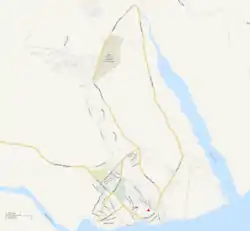Bumneng
Bumneng is a suburb of Lae in the Morobe Province, Papua New Guinea.
Bumneng | |
|---|---|
Suburb | |
 Panoramic view of Lae Polytechnic College (formerly Lae Technical College). Facing south east | |
 Bumneng Location in Lae | |
| Coordinates: 6°42′50″S 146°59′11″E | |
| Country | |
| Province | Morobe Province |
| District | Lae District |
| Time zone | UTC+10 (AEST) |
Location
The location of Bumneng, according to the Lae telephone directory[lower-alpha 1] is west of Bumbu River, north of Botanical Gardens, east of Eriku and south of Omili.
Within the suburb of Bumneng is the Admin Compound, Soccer Association, Lae Botanic Gardens and Lae Polytechnic College.
Lae Polytechnic College
Lae Polytechnic College is located on Milford Haven Rd at the junction of Bumbu Road Bumneng.
Formerly Lae Technical School it was established is in 1953 at Busu Secondary grounds and relocated to present site between 1954 and 1955. In 1965 the school was changed to a college. On December, 2009, the status changed again from college to a polytechnic institute and is now called the National Polytechnic Institute of PNG in line with the National Education Plan.[2] In 2011 a study found that employers were dissatisfied with the services provided by the colleges and strongly emphasised the need for a coordinating education authority.[3]
In 2013 expansion plans for the Institute were impeded by illegal settlements near the National Polytechnic Institute.[4]
Admin Compound
The Admin Compound is located between the Bumbu River and behind the Lae Polytechnic College. According to census date, there are 47 households with a population of 381 persons.[5]
Flooding
Between December 1983 and July 1992, Lae experienced two major flood and mudslide disasters. In both cases, hundreds of people lost their homes. The 1983 floods remain the worst since the establishment of the town in the late 1920s. These floods left hundreds of people homeless particularly those living along the banks of the Bumbu River. Many houses were damaged or completely destroyed and hundreds of people at the Five Mile settlement along the Highland highway were also affected by mud-slides.[6]
Meanwhile, provincial and national leaders met to find solutions to the problem of how to resettle people displaced by the disaster and to the north of the city a block of land was allocated, planned and developed for the resettlement of the disaster victims. This 'Tensiti' settlement was developed in 1992 on the former Serafini plantation with sealed road networks, water and electricity.[6]
During the 2007 floods engineers were also working out how the flooding Bumbu River in Lae would be diverted to save residences at Admin Compound which were threatened by the floodwaters.[7]
Notes
- Lae telephone directory is available in hard copy only from PNG Directories Limited. Map 3 coordinates J8. Few online maps mention this suburb.[1]
References
- "Papua New Guinea (PNG) White Pages - Telephone Directory". Archived from the original on 2014-03-25. Retrieved 2014-02-28. Papua New Guinea White Pages
- "EDUCATING & SKILLING THE WORKFORCE" (PDF). PNG Institute of National Affairs workshop 2012. NATIONAL POLYTECHNIC INSTITUTE. Retrieved 24 February 2014.
- "PNG TVET needs analysis study final report July 2011" (PDF). AusAid. Archived from the original (PDF) on 12 February 2014. Retrieved 24 February 2014.
- "Settlers prevent Lae Polytech's expansion". PNG Education News. Retrieved 24 February 2014.
- (NHASP), National HIV/AIDS Support Project (2005). Situational analysis for strategic planning at district level (PDF). Papua New Guinea: National HIV/AIDS Support Project. p. 88. ISBN 9980-86-010-3.
- 1996 KAITILLA, S & YAMBUI, A Intervention in PNG: The Case of Lae, Disaster Management and Government
- RSOE EDIS. "Flood in Papua New Guinea on Tuesday, 14 August, 2007". Archived from the original on 26 February 2014. Retrieved 23 February 2014.